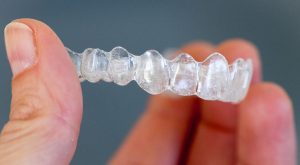Hawley Retainer: Is It the Right Treatment for You?

One of the most popular orthodontic retainers around today is called the Hawley retainer. There are many reasons why it is the most popular but the main reason if most definitely because this retainer does what it is supposed to do—as well as working smoothly and efficiently. This article is to help you learn more about the Hawley retainer, as well as whether it would be a good fit for youor if you might need help from another type of retainer.
The different type of retainers
First, let’s talk about each kind of dental retainer that can be used on both the upper teeth and the lower teeth so you can best see if a Hawley retainer would benefit you or not.
Hawley retainers
Hawley retainers are the most popular retainers available today.These retainers also happen to be the most easily recognized; when you think of retainers, chances are an image of Hawley retainers pops up in your head. Also called wire retainers, this type of retainer has been around forever and are made from a custom mold of the patient’s mouth. These retainers are removable, making it easy to eat, brush your teeth, and clean the retainer when needed. To help keep your teeth straight and in place, these retainers hold your teeth in place and can always be adjusted if they need to be.
Permanent retainers
Permanent retainers are just that: permanent. While Hawley retainers are removable and can be easily (and pain-free) removed by the patient, permanent retainers cannot be removed unless an orthodontist does it for them. These types of retainers are also called fixed retainers, a lingual retainer wire, or bonded wire retainers. While permanent retainers aren’t as common as Hawley retainers are, it is common for patients to get permanent retainers on the lower half of their teeth, as the lower half of the mouth is easier to move and shift (and, therefore, quickly lose their straightness and move back to their former position).
Clear retainers

Hawley retainer advantages and disadvantages
Now that we have a basic understanding of all the different retainers let’s talk about what, the advantages and disadvantages are of Hawley retainers.
Advantages
These retainers are incredibly strong and durable, especially compared to clear retainers. While they aren’t going to be as durable as permanent retainers (merely because they aren’t permanent), these retainers are still very strong. The wiring allows for that stability that clear retainers lack. Knowing that your retainer is st
These retainers also allow teeth to “settle” in the back of your mouth, which can help if you have either an upper bite or a lower bite. For those that have issues with alignment in their mouth, these retainers are excellent to help settle some problems you might be having. This, again, goes back to how sturdy and durable they are. While permanent retainers also offer this, clear ones don’t and just aren’t as stable.
Finally, the wire part of the retainer can also be adjusted to fit a tooth as need be, resulting in a straightforward and very comfortable solution if you’re ever uncomfortable. This is something that permanent retainers don’t offer in the least, as you can’t do anything to those types of retainers (and only dentists can). Therefore, these retainers are as durable as permanent ones, yet as flexible as clear ones can be.
Disadvantages
One of the most significant drawbacks for most people, in regards to this specific retainer, is the fact that the wire is visible. No one likes having evident braces or retainers and life is just more comfortable when things are clear or transparent. Therefore, the visible wire is a massive disadvantage for some people. For others, not so much.
Another quite significant disadvantage is this retainer can tend to affect speech because of the acrylic that covers the roof of your mouth. Because of this, your speech can come out different and less clear, which is never ideal. Also, these retainers seem to always be misplaced or broken by patients, which isn’t great. Because they are removable, they can be easily lost or misplaced like that. Trust us, you might think you would never lose them…until you do entirely by accident.
Finally, the last disadvantage reallyjust depends on the patient. Sometimes, these retainers can be less effective than permanent retainers—but that’s only if the patient doesn’t use them like they’re supposed to. They’re removable, which means wearing them is solely up to the patient. So, if they’re not used as often as they should be, the results aren’t going to be as perfect as they could be (and as permanent retainers often are).
As you can see, there are some definite advantages and disadvantages to Hawley retainers. They are incredibly durable, though they aren’t as clearor as unnoticeable as some people may hope. However, they get the job done quickly and efficiently, which is always a plus. Now that you know a bit more about retainers make sure you talk to your dentist or orthodontist as they help you decide which type of retainer is best for you and your lifestyle.
Relate Posts to Read:
Teeth Retainer Options to Reduce Pain
